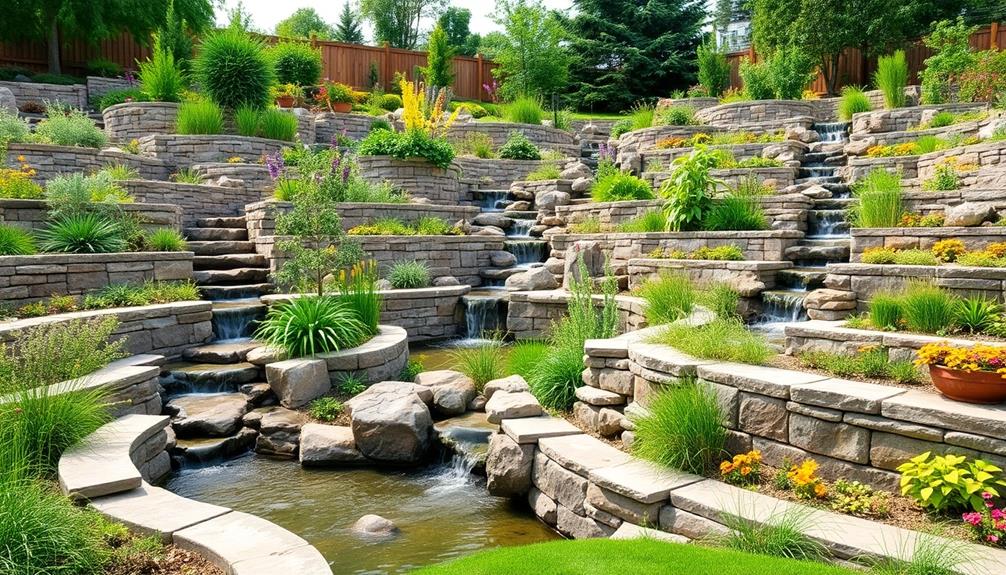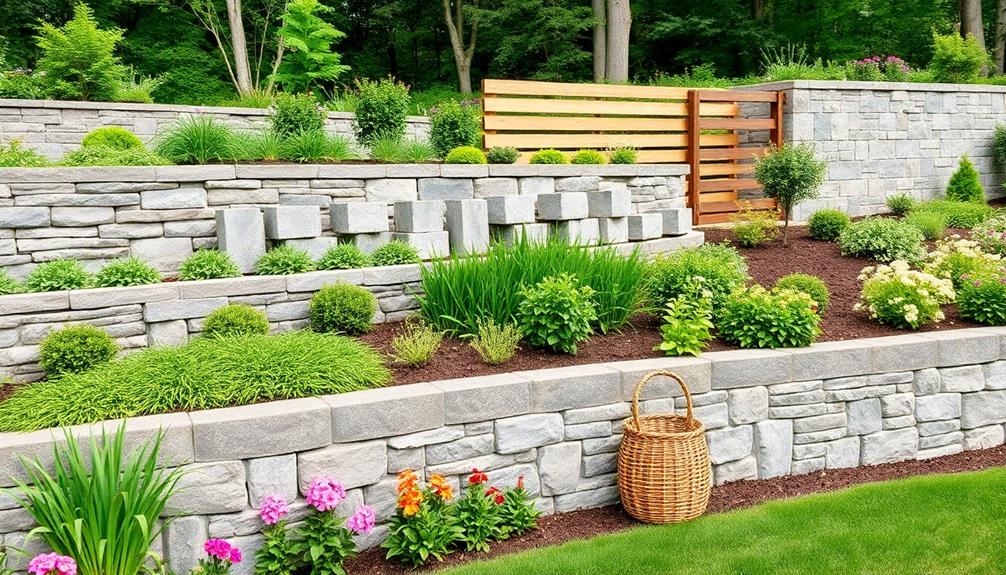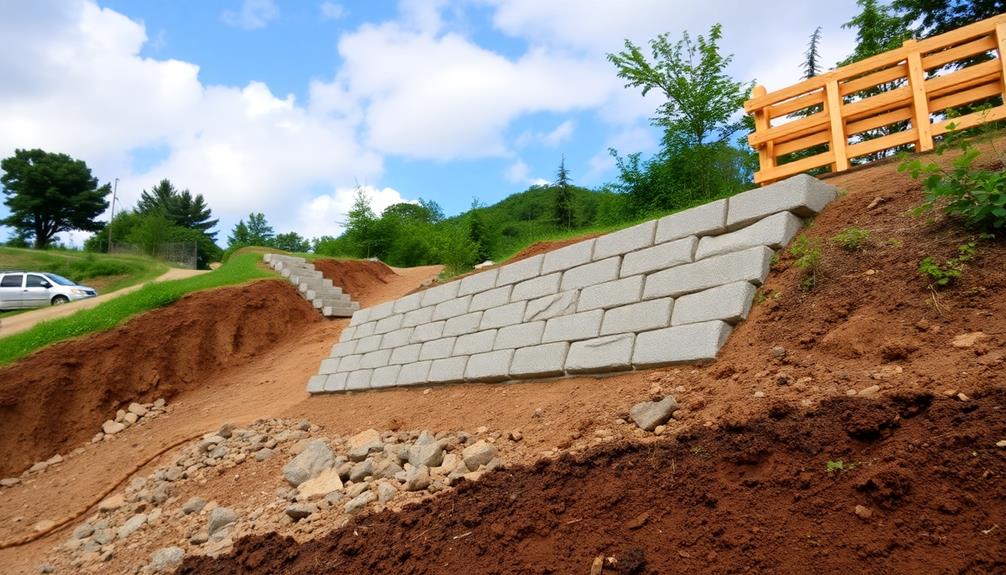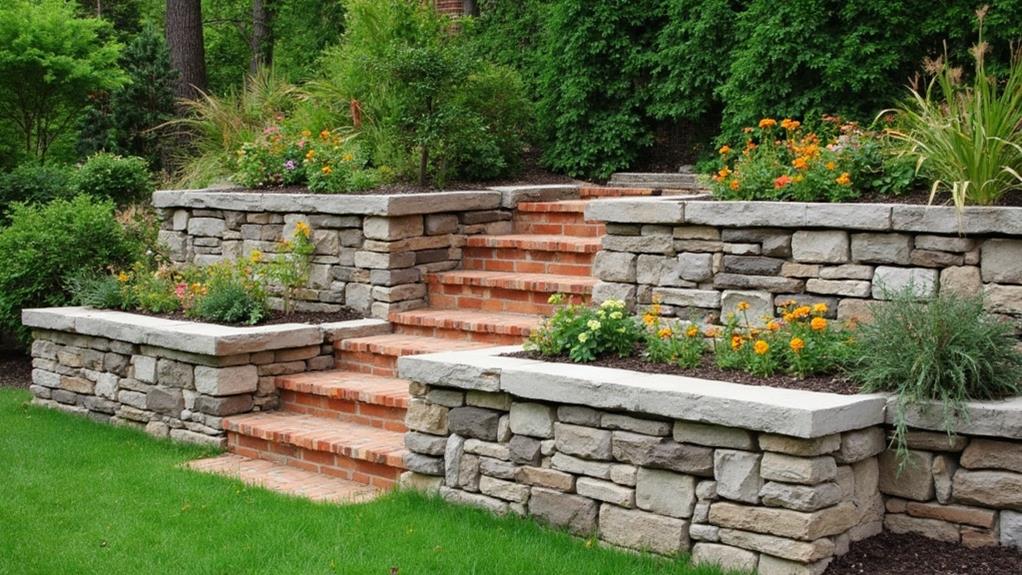Retaining wall materials, including concrete, natural stone, and treated wood, each present unique benefits and challenges. Concrete is renowned for its sturdiness and resistance to weather conditions, while natural stone is valued for exceptional longevity and minimal decay. Treated wood provides improved resistance to rotting and termite damage. Selecting the right material influences not only the structural integrity and durability but also the aesthetic appeal and integration into landscape design. These materials serve critical functions, such as mitigating soil erosion, stabilizing sloped areas, and enhancing water management. Exploring material choices reveals how they align with environmental and design goals.
Table of Contents
ToggleWalls Contractor Highlights
- Concrete retains strength and durability, ideal for withstanding harsh weather conditions.
- Natural stone provides exceptional longevity and a classic aesthetic appeal.
- Treated wood offers affordability, but may require regular maintenance against rotting and termites.
- Brick offers versatility in design, creating diverse visual elements while maintaining structural integrity.
- Interlocking concrete blocks facilitate easy installation and customization without needing mortar.
Defining Retaining Wall Functions

Retaining walls serve a critical function in mitigating soil erosion by providing the necessary structural support to retain soil in sloped areas, thereby preventing landslides and the loss of valuable topsoil. Additionally, they route rainwater away from homes, protecting the foundation and reducing water damage.
Further, they facilitate enhanced landscape design possibilities, enabling the creation of tiered gardens and usable outdoor spaces in terrains that might otherwise be unsuitable due to their natural gradients. Understanding these functions underscores the importance of selecting the appropriate materials to guarantee longevity, stability, and aesthetic appeal in their construction.
Purpose of Retaining Walls
The primary function of retaining walls is to stabilize soil and prevent erosion on sloped landscapes. These structures not only hold back soil that would otherwise slide due to gravity but also play a pivotal role in transforming uneven terrain into usable, aesthetically pleasing spaces. By creating level, functional areas, retaining walls enable the integration of further landscaping elements, such as gardens or pathways, fostering a harmonious environment. This structural intervention allows property owners to maximize the utility of their land, ensuring that each corner contributes to the cohesive vision of their outdoor living areas.
Retaining walls serve as critical foundations in landscapes, extending beyond mere functionality to influence the visual and spatial harmony of a site. They can guide water flow, redirecting runoff in a controlled manner that prevents detrimental pooling or flood scenarios. Properly installed, these walls enhance the structural integrity of surrounding features, laying the groundwork for future architectural or horticultural enhancements. Consequently, they contribute to the safety and sustainability of residential and commercial properties, solidifying their place as an essential component of modern landscape design. In this way, retaining walls meld practicality with aesthetic appeal, creating enduring environments that resonate with clarity and precision.
Soil Erosion Prevention
Effectively mitigating soil erosion involves addressing this natural challenge through strategic landscape architecture. Retaining walls play a pivotal role in curbing soil erosion, holding the terrain in place under varying environmental pressures. These structures not only protect against gradual soil displacement caused by water runoff and wind but also stabilize the landscape's integrity against the incessant forces of nature. By creating a barrier that captures and redistributes water efficiently, retaining walls minimize the detriments of erosion, which can lead to landscape degradation and property damage over time.
Retaining walls' ability to prevent soil erosion hinges on their material composition and structural design, factors that must be harmonized with the local ecosystem. Materials like concrete, stone, or timber each bring unique characteristics to erosion control, providing options that can align with aesthetic preferences and specific geographical needs.
For communities and property owners, the construction of retaining walls fosters a sense of unity and belonging, as they contribute collectively to more sustainable environmental practices. They embody a commitment to preserving the landscape, ensuring its longevity for future generations. In this way, choosing the right materials and design becomes a collaborative endeavor, aligning individual needs with community sustainability goals.
Landscape Design Benefits
Bridging functionality with aesthetic appeal, retaining walls serve as essential components in landscape design. Their multifaceted role goes beyond simply preventing soil erosion; they transform ordinary outdoor spaces into exquisite backdrops that resonate with harmony and purpose.
Retaining walls create terraced gardens, offering varied elevation that enhances visual interest, while ensuring the efficient use of space in sloped terrains. This aspect becomes indispensable for individuals seeking both stability and beauty in their environments, fostering a sense of belonging to a thoughtfully crafted habitat.
From a design perspective, retaining walls can be constructed using diverse materials such as stone, concrete, wood, or brick, each contributing distinct textures and colors that seamlessly blend with the surrounding landscape. These materials not only provide structural support but also infuse character, allowing homeowners to reflect their personal style and taste in their outdoor settings.
Additionally, retaining walls can delineate spaces, serving as seating, planters, or subtle boundaries that encourage gathering and interaction among loved ones.
Through their strategic placement and design, retaining walls elevate the functional and aesthetic quality of landscapes, fostering a cohesive and inviting atmosphere where individuals can find connection with the natural world around them.
Benefits

When evaluating the benefits of different retaining wall materials, several key factors emerge as essential in influencing decision-making. Considerations of durability and longevity are paramount, as they guarantee the structure can withstand environmental pressures over time without frequent replacement.
For example, the Granite Company, with over 20 years of experience, highlights the importance of structural integrity and proper grading to verify walls can endure various weather conditions. Additionally, the aesthetic versatility and appeal of various materials offer opportunities to enhance landscaping designs, while environmental impact assessments and cost and maintenance implications further inform choices by balancing ecological responsibility with economic efficiency.
Durability and Longevity Considerations
The choice of materials for retaining walls greatly impacts their durability and longevity, making it a critical factor in construction decisions. Properly selecting and employing durable materials can guarantee the structure's ability to withstand erosive forces and varying weather conditions over time.
For example, concrete, known for its sturdiness, offers significant resistance against harsh environmental elements such as water intrusion and temperature fluctuations. This inherent strength helps minimize maintenance needs and prolongs the structural life of the wall.
Conversely, natural stone provides exceptional longevity owing to its innate resistance to decay. Its organic composition assures that it maintains integrity over long durations. Additionally, treated wood, while not as permanent as stone or concrete, boasts modern treatment methods that enhance resistance against rotting and termites, extending its useful life in the right applications. Each material offers unique benefits that can align with the specific durability goals of a project.
Ultimately, understanding how different retaining wall materials interact with environmental stressors is essential in making informed choices. By making careful material selections, you can enhance the community's landscape, creating functional spaces that stand the test of time and provide a sense of stability and cohesion.
Aesthetic Versatility and Appeal
Retaining walls offer numerous aesthetic advantages, allowing for a blend of functionality and visual appeal in landscape design. These versatile structures serve as more than just utilitarian components; they redefine spaces, crafting harmonious outdoor environments that speak to both practical needs and aesthetic aspirations. Whether fashioned from natural stone, concrete, or timber, retaining walls provide a plethora of design options that can be tailored to complement diverse architectural styles and personal tastes.
Natural stone walls lend a timeless elegance, seamlessly integrating with the landscape and providing a sense of permanence and authenticity. Their varied textures and colors add a unique character, enhancing the natural beauty of a garden. Concrete retaining walls, on the other hand, present a modern aesthetic with clean lines and the capability for customization through staining, texturing, or even incorporating decorative inlays, appealing to contemporary design sensibilities.
Timber walls, with their organic warmth and rustic charm, create inviting landscapes that foster a sense of belonging to the natural surroundings. This flexibility in materials and design means retaining walls can serve as cohesive elements, fostering community appeal and inviting residents to appreciate and connect with the environment around them, enhancing communal green spaces.
Environmental Impact Assessments
In addition to their aesthetic versatility, the choice of materials for retaining walls can notably influence their environmental impact. Retaining walls serve as pivotal landscape features, and selecting eco-friendly materials enhances their sustainability. Natural stone, for instance, presents a lower carbon footprint compared to manufactured products, aligning well with the community ethos of environmental stewardship. Additionally, locally sourced stone reduces transportation emissions, supporting the ethos of regional identity and unity.
Recycled materials, such as crushed concrete, exemplify how repurposing project remnants can positively affect environmental impact, resonating with a collective desire to promote resourcefulness and waste reduction. These materials not only conserve natural resources but also help communities affirm their commitment to sustainable practices.
Furthermore, timber sourced from sustainably managed forests is an excellent choice, offering worry-free biodegradability post-life cycle, thereby reinforcing the long-term collective responsibility towards nature.
Moreover, the use of modular concrete systems that integrate advanced drainage technology ensures the structural durability of retaining walls with minimal ecological disturbance. Such solutions highlight a shared innovation drive, fostering a collective pride in adopting efficient, environmentally sound practices that align with communal values. Emphasizing sustainable choices for retaining walls enhances environmental benefits while strengthening communal identity and responsibility.
Cost and Maintenance Implications
Investing in well-chosen retaining wall materials can drastically reduce long-term costs and maintenance efforts. For communities and individuals keen on fostering aesthetically pleasing, sustainable environments, selecting the right materials is indispensable. Concrete, while initially more expensive, offers longevity and durability with minimal upkeep, often translating to noteworthy savings over time.
Engineered wood, on the other hand, provides a unique blend of natural aesthetics and tensile strength but demands regular inspections and treatments to prevent decay, influencing subsequent expenditures.
Moreover, natural stone, renowned for its timeless elegance and impermeability, presents a favorable option for those desiring minimal yearly maintenance. Although the upfront investment may be higher, its resistance to weathering provides a long-term reduction in concerns about repairs or replacements.
Additionally, the use of recycled materials, such as crushed concrete or reclaimed wood, not only benefits the environment but can also considerably lower initial construction costs. These materials often require routine checks to confirm structural integrity but confer community-oriented solutions that align with eco-conscious principles.
Incorporating local resources can also curtail transportation fees, underscoring the importance of strategic material choices which contribute to sense of community and shared responsibility in maintaining the landscape efficiently.
Common Installation Challenges

When installing retaining walls, various challenges can arise, primarily revolving around soil stability, the necessity for appropriately designed drainage systems, and the precision required in cutting materials. Soil stability concerns necessitate thorough evaluation and potential reinforcement to prevent future structural failure, while proper drainage systems are imperative to mitigate water buildup that could compromise the integrity of the wall. Meanwhile, precision cutting challenges involve the meticulous shaping of materials to guarantee a seamless fit, which is essential for both aesthetic and functional purposes.
| Challenge | Description |
|---|---|
| Soil Stability Concerns | Evaluating and reinforcing to prevent structural failure. |
| Drainage System Requirements | Designing systems to prevent water buildup. |
| Precision Cutting Challenges | Shaping materials meticulously for perfect fit and function. |
Soil Stability Concerns
A critical challenge faced during the installation of retaining walls is the concern over soil stability. The underlying soil must possess adequate strength and cohesion to support the substantial weight of the wall itself, as well as the forces exerted by the retained soil. Inadequate soil stability can lead to wall failure, necessitating a thorough assessment of the geological conditions before construction begins.
Understanding the soil's properties, such as bearing capacity and compaction, is pivotal to designing a structure that not only satisfies safety requirements but also provides enduring service.
Soil stability largely affects the choice of materials and specific engineering approaches. Proper identification of soil type, whether clay, silt, sand, or gravel, informs the necessary measures to enhance stability, such as soil reinforcement through geogrids or geotextiles. These reinforcements strengthen the soil structure against shear stress, minimizing the risk of settlement or slippage.
Investing time and resources into an extensive geotechnical evaluation can foster a sense of confidence and assurance in the project's success, binding together the interests of stakeholders towards a common goal. This meticulous groundwork sets the stage for enduring retaining wall solutions, harmonious with both environment and community.
Drainage System Requirements
Addressing soil stability establishes the groundwork for another pivotal aspect of retaining wall projects: the drainage system. Ensuring effective drainage is essential to mitigating hydrostatic pressure buildup behind retaining walls, which may compromise their structural integrity over time. Without a well-designed drainage system, water can accumulate, putting undue stress on the wall and leading to potential wall failure. Consequently, integrating both surface and subsurface drainage measures is paramount to maintaining both stability and longevity.
Key components of an efficient drainage system include gravel backfill and perforated drainpipes, specifically designed to capture, filter, and redirect water away from the structure. Gravel acts as a buffer, allowing water to percolate, thus minimizing lateral pressure. Perforated pipes, typically embedded at the base of the wall, further facilitate the expeditious removal of excess water. These elements work in tandem to safeguard against the erosive forces of water infiltration.
Furthermore, installing weep holes, strategically placed openings within the wall, serves an additional purpose of relieving pressure by allowing water to escape naturally. When these fundamental drainage solutions are implemented effectively, they play an instrumental role in reinforcing the overall resilience and functionality of retaining wall systems, ensuring they serve their intended purpose for years to come.
Precision Cutting Challenges
During the installation of retaining walls, precision cutting emerges as a common challenge that can greatly impact the overall outcome. Achieving exactness while cutting materials ensures structural integrity and aesthetic harmony, reflecting both the technical skill and artistry involved in such projects.
Different materials, whether they be natural stone, concrete blocks, or wood, offer distinct challenges and require specific tools and techniques to guarantee clean and precise cuts. Errors in precision cutting can lead to gaps, uneven surfaces, or weakened structures, which may ultimately compromise the wall's function and longevity.
For those who value detailed craftsmanship and reliability, addressing these challenges is essential. Professional installers often rely on high-quality equipment such as diamond-tipped blades for stone and concrete, or carbide-tipped saws for wood, ensuring each cut aligns with stringent design requirements.
Additionally, understanding the unique properties of each material allows for strategic planning and execution, minimizing waste and maximizing material performance. Precision cutting not only enhances the aesthetic appeal by creating seamless connections and uniform textures but also plays a critical role in ensuring stability and durability. As such, approaching this challenge with expertise fosters a sense of trust and belonging within your project team.
Walls Contractor FAQ
How Do Different Materials Impact the Environmental Sustainability of Retaining Walls?
Different materials profoundly impact the environmental sustainability of retaining walls by influencing factors such as resource extraction, energy consumption, and recyclability. Choosing eco-friendly materials fosters sustainable communities, harmonizing with nature while ensuring structural resilience and societal inclusivity.
What Is the Average Cost Comparison Between Various Retaining Wall Materials?
The average cost of retaining wall materials varies greatly: timber is often the most affordable, followed by concrete blocks, stone, and brick. Costs are influenced by factors like material quality, installation complexity, and regional pricing variances.
How Does Climate Affect the Longevity of Different Retaining Wall Materials?
The longevity of retaining wall materials is dramatically influenced by climate; materials like wood may degrade faster in moist conditions, while concrete and stone offer resilience in varied climates, ensuring durability and a sense of long-term security.
Can Retaining Wall Materials Accommodate Different Design Aesthetics and Themes?
Retaining wall materials can indeed accommodate various design aesthetics and themes, enhancing landscape appeal. Options such as stone, concrete, or timber offer diverse textures and colors, allowing integration into modern, traditional, or rustic settings seamlessly.
Are There Specific Maintenance Practices Required for Each Type of Retaining Wall Material?
Each retaining wall material necessitates distinct maintenance protocols to guarantee longevity and structural integrity. Engaging in regular inspections and addressing issues promptly fosters a sense of ownership and pride within the community, promoting shared responsibility in landscape preservation.







